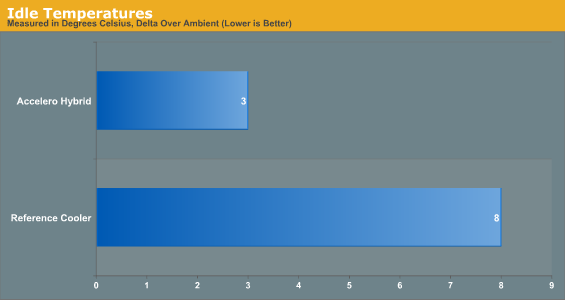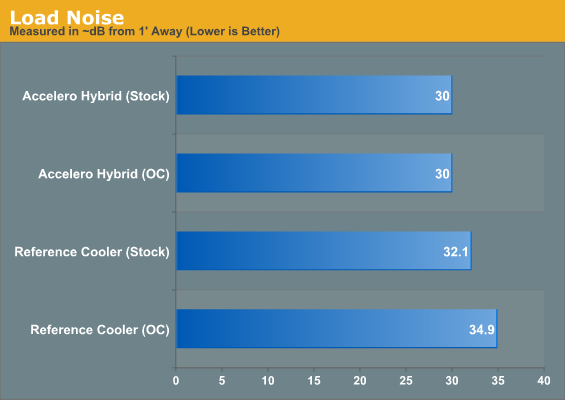Arctic Cooling Accelero Hybrid VGA Cooler Review: Not For the Faint of Heart
by Dustin Sklavos on December 28, 2012 8:15 PM EST- Posted in
- Arctic Cooling
- graphics
- cooling
Performance Results
Of course, for the Arctic Cooling Accelero Hybrid, the proof is in the testing. Once I was satisfied that I hadn't bricked the GeForce GTX 680 during assembly, I went about testing it in eVGA's OC Scanner X software. I've actually been pretty happy with OC Scanner X in personal use, and it generates enough heat to give the coolers a good workout.
I will say that what I found in testing, while not necessarily unexpected, was still pretty impressive.
Ambient temperature during testing was ~21C.

Unsurprisingly, idle temperatures are pretty impressively low for both cooling systems, but already the Accelero Hybrid is able to produce a substantially better result well outside of the margin of error.

Once a load is applied to the card, though, all bets are off. The Accelero Hybrid blows past the reference cooler, producing a massive reduction in thermals. Keep this in mind, I'm going to come back to it later.

Since the reference cooler and Accelero Hybrid both idle below the 30dB floor of our sound meter, idle noise results aren't listed. What's impressive is that the Hybrid is almost dead silent under load, regardless of the increased pressure applied to the cooling system. So while the reference cooler gets louder the harder you push the card, the Hybrid seems to have plenty of thermal headroom to spare.
Using the Arctic Cooling Accelero Hybrid on the GTX 680 has also revealed another interesting wrinkle. While overclocking on the GTX 680 is mostly limited by the Power Target, the reference cooler definitely introduces some thermal limitations. I've seen the GPU clock of the 680 take a step back and begin to throttle a little once it goes north of 70C, but because the Accelero Hybrid has so much thermal headroom, that throttling almost never happens. With the fan control manually maxed out at 85%, I registered a noise level of just 31.3dB in testing, but have actually been able to push the 680 north of 1.3GHz. The stable 6.6GHz clock on the GDDR5 has been consistent between the reference cooler and the Hybrid, but the added headroom for the GPU has allowed me to move past the ~1.2GHz I was able to attain on the stock cooling.
As I've been writing this review, I've actually been steadily testing overclocking on the GTX 680 plus Hybrid by incrementing the GPU Offset +10MHz, running it through OC Scanner X for fifteen minutes (and accepting no artifacts), then benchmarking it in 3DMark 11's Extreme test. This is by no means a thorough stability test, but it's a decent way to poke around the edges of the card's tolerances. I can't imagine how much hotter and louder it would be running with the reference cooler, but with the Hybrid at 85% it's peaking at 63C. That's at 1.3GHz, sustained load.










47 Comments
View All Comments
nosaj999 - Thursday, January 3, 2013 - link
Conveniently NewEgg has put this beasty on sale!http://www.newegg.com/Product/Product.aspx?Item=N8...
xcomvic - Thursday, January 3, 2013 - link
Get it while it's hot! Please update the article with new price at the end. This will definitely make it a stronger case for an award don't you think?qepsilonp - Tuesday, April 30, 2013 - link
I would consider buying it if it wasn't stuck on that GPU so I could maybe use it on my next GPU given that I personally couldn't justify the price.dllyncher - Tuesday, May 28, 2013 - link
I just installed this cooler on my EVGA GTX 660ti Signature2 FTW and my temps are kind of confusing. Idle temps are around 24C which is the same as the stock cooler. The unusual part is that while running EVGA OC Scanner for 10 minutes, temps reach 45C versus 39C with the stock cooler. I know I have installed it properly as I've checked many times. If anyone is having the same problems please let me know so I know it's not just me.Maleorderbride - Thursday, July 11, 2013 - link
My Titan was only running at ~68% of TDP at 88F ambient (hot, I know) and this thing cooled the VRMs enough that I am now at 93.4% TDP at the same ambient.Installation was a needless trial, but put a movie on and take your time.
theNiZer - Saturday, December 7, 2013 - link
I really like this unit - much more than the now popular Kraken G10, because you can fit Accelero Hybrid in a mini itx case!And of course, being able to 'pump' the how gpu air out of the mini itx case is important to avoid gpu throttling and maximize efficiency.
Combine this with coolermaster Elite 130, nice!
editorsorgtfo - Thursday, September 18, 2014 - link
The best HSFs are spiffy coolers, but there are drawbacks to using the most efficient ones. The impressively-high-performing, dual-tower/dual-fan Noctua NH-D15 exemplifies them: first, it stands quite tall, at 16.5 cm, and can present a space problem in less than capacious cases. It is wide, and can preclude the use of RAM with any but the most modest heat spreaders, since memory stick height is limited to 32 mm. It is also massive, weighing in at 1.32 kilos -- almost 3 pounds! -- and has a high center of gravity, due to its stature. The effect of that much leverage on a vertically-mounted motherboard, if jostled, can easily be total destruction, with the processor, socket and rear mount being ripped right out! Even the static torque of the NH-D15, over time, could lead to mobo failure, which may not be covered by warranty.None of those issues exist where using a CLC, even one with integrated waterblock and pump: Silverstone's brazed, screwless waterblock eliminates a major point of leakage; Antec's Kühler further reduces obtrusiveness and physical stress on the motherboard by moving the pump(s) off-block to the fan axles.
Rig damage by cooler sux, whether it's the result of fluid leakage from an AIO or excessive weight of a HSF pulling a board apart. Maybe a bungee counterbalancing a massive HSF would quietly help alleviate gravitational torqueing of the motherboard; if you install a CLC, inspect it often for signs of loss of seal integrity and leakage. "To be forewarned is to be forearmed."
Each type of cooling systen has its strong points, yet comes up short in others. Given a bit more development time, CLCs will become more refined, and their problems largely ironed out.